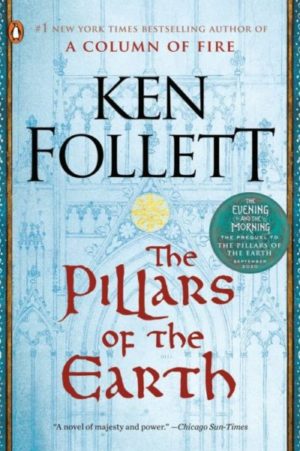Genre: Historical fiction, England 1123-1174.
Length: 983 pages.
Classics transcend their time, and THE PILLARS OF THE EARTH is a classic. When it was released in 1989, it was hailed as a triumph and surprise by a well-known spy-thriller novelist. Follett continued the series with installments in 2007 and 2017, and a prequel in 2020. As a classic, it continues to be relevant and new to anyone who hasn’t yet read it.
The novel starts with a short newsy notice of the sinking of The White Ship; followed by a prologue drama of a hanging at the village of Shiring and a curse by the hanged man’s lover.
The main story then begins with Tom, a mason, who is suddenly out of work when the manor he is building is stopped because Aliena, the expected bride, daughter of the earl of Shiring, rejects William Hamleigh, the groom from an up-and-coming family who was funding the project. Tom must look for work anew. He is hoping to be appointed as a master builder of a cathedral, but without any job at all, he is destitute and unable to support his wife and children.
The life of feudal England is brought into sharp relief at every turn of the page, with a world of humble houses with rushes on the floor, hunger sated with weak beer and peasant bread. We are led into the prayerful life of the monastery at Kingsbridge, see inside the cave and life of outlaws in the forest, and experience the hard work of ordinary villagers. The story swirls around the building of a cathedral at Kingsbridge, and the lives and intrigues of Tom Builder, Aliena the Earl’s daughter and William Hamleigh, the Prior Philip and Bishop Waleran Bigod, and the witch Ellen and Jack, her son from the hanged man.
The sheer scope is awesome. The charcters’ stories are interesting and woven together inextricably in a fascinating and compelling way. The big reveal at the end is not a surprise, as there are ample hints and information for the reader to have figured it out, but it is sufficiently satisfying to have it corroborated.
The book suffers from some information dumps, for example where the rivalry between the potential heirs of Henry I is laid out. The excessive details of building in the twelfth century slow the pacing in the last third of the book, without great benefit. Another issue is the limited cast of women, without much distinction or difference in personality—the few who are there are all strong, assertive, independent. And except for rape, the sexual encounters depicted all start with women exposing their bodies to the man of their desire, which seems to be more male fantasy than historical material.
Despite these limitations, the book tells a fascinating story at an intriguing time. It relies more on realism than romanticism to recreate the past. It raises, but doesn’t fully answer, questions about the venality of the church and the violence and insecurity of the feudal period. This is a book that will appeal to anyone with an interest in the story of individuals and their relationships, in history, or in the feudal Middle Ages.
Stars: ****

